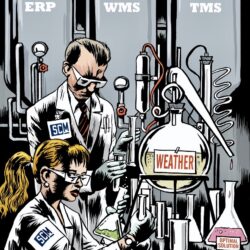Data science unlocks unexpected insights

Data science provides extra insight into parts of the supply chain that standard software can’t reach, whether in the area of manufacturing, warehousing, forecasting or inventory management. In order to get ahead, companies will need to invest in process mining, machine learning, deep learning or other forms of artificial intelligence. One key question they face is how to organize it: with their own team of data specialists or via an external supplier?
By Marcel te Lindert
The Fischer Group in Horb, southern Germany, has 65 injection moulding machines producing automotive components. The factory is a hive of activity, with people operating the machines, gathering the components and resolving any technical problems. The company knows exactly which tasks each of these people must execute, but up until recently had no idea how they could do so efficiently. “That’s why we fitted a number of employees with movement sensors: two on their wrists and one on their waistband. The sensors transmit their data by Bluetooth to an app on the relevant employee’s smartphone. The same holds true for all the beacons we’ve installed throughout the factory,” says Jan Greschner from Fischer Consulting, which is part of the Fischer Group.
The movements of two shifts of employees were tracked every day for a week, generating more than a billion data points in total. The movement patterns were then reconstructed using the artificial intelligence from MotionMiners, which also developed the sensors, beacons and app. The results were then visualized on the MotionMiners platform. “Interestingly we discovered that, on average, an employee covers more than ten kilometres during a shift. They walk from one machine to the next machine to check whether they need to do anything – and often they don’t, so they move on to the next machine. Alternatively, they wait at the machine until the components are ready for them to collect. All that walking and waiting wastes a huge amount of time,” explains Greschner.
The artificial intelligence from MotionMiners revealed other insights too, such as that employees were spending more time than expected on all the paperwork. “Yet that’s easy for us to automate,” adds Greschner. “Besides that, we’re considering giving every employee a smartwatch so that they can see, for example, that intervention will be required at Machine 53 in 30 seconds’ time. That eliminates unnecessary walking. If we implement all the recommendations from the movement analysis, we can reduce the time our employees spend on these specific tasks by 16%.”
Digital champions
The use of artificial intelligence in the supply chain is on the rise. According to a recent study by PwC, 70% of the companies surveyed use machine learning, deep learning or another form of artificial intelligence in at least one part of their supply chain. Even companies that have a lower level of digital maturity are exploring the opportunities and investing in data science. “But the digital champions are way out in front. They are two to three times more likely to be using artificial intelligence than ‘digital beginners’,” states Martin Whyte, Director Connected Supply Chain at PwC and co-author of the report.
Companies utilize data science to increase their supply chain transparency, optimize the cost to serve or improve their customer service based on segmentation. Whyte: “Another example is planning. Forecasting demand based on historical data alone results in over- or under-forecasting and hence suboptimal stock levels. The use of more future-oriented and other kinds of data about customer behaviour in combination with new technologies such as machine learning increases the predictive strength. That not only helps to improve the reliability of the forecast, but also enables detailed forecasts per product, per hour, per store and so on. This leads to higher product availability and greater customer satisfaction.”
Solutions that help companies to set themselves apart generally go beyond the capabilities of standard software. Those solutions have to be extended with data science tools or specially developed algorithms, according to PwC: “Companies use standard software to create a supply chain data network so that they can gather and then interconnect all the relevant data – which is necessary in order to analyse the data in real time. But besides that, each company will always have to configure its own supply chain data network based on the own unique logic and design of its supply chain.” … … …
 Want to read more?
Want to read more?
Subscribe to the digital subscription to read the full version >>
or
This article was first published in Supply Chain Movement 38 | Q3 – 2020










